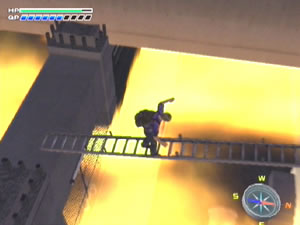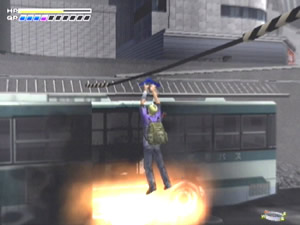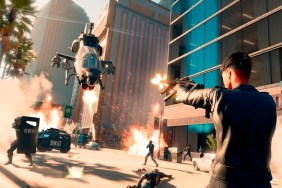Shake, rattle and roll.
The Bay Area has a certain shaky reputation. From the Great San Francisco Quake
of 1906 to the
recent 1989
jostle that collapsed a bridge and stopped a World Series, it feels like life
here is simply waiting for the other shoe to drop. Scientists predict that one
day, thousands of years from now, the entire West Coast will sink into the ocean.
I’ll be dead, so what me worry…but what of Johnny Liu Jr., Jr., Jr. III? Will
he be prepared?
So, here’s what I’m going to do for my future descendent. I’m going to shrink-wrap
my PS2 with the game Disaster Report. That way, he can get a palpable
sense of earthquake terror. Johnny Jr. 5 might even be able to appreciate
Disaster Report as an artistic relic!
But
as a game, Disaster Report could use some CPR.
Disaster Report is a survival horror game, but not of the traditional
ilk. No zombies, no dinosaurs, and no zombie-dinosaurs. This time you are running
from something you can’t run away from. Everywhere you run, it’s always there.
Earthquakes.
Keith Helms, a journalist, has traveled to the man-made Stiver Island to begin
his new job at the Town Crier. On his way there, an earthquake rocks the island,
crippling the metropolis and leaving Keith stranded on a collapsing bridge.
Keith must make his way to safety, or end up as another statistic.
In order to survive this adventure game, Keith must find objects and use them
to solve problems. At the same time, he must run away from falling debris. Remember
to duck and cover.
What I find most satisfying about this game is the refreshing sense of urgency.
The environments, in their crumbling erosion, feel like a real present day city.
At the height of an aftershock, the screen can completely turn on edge, as desks
and shelves slide away. It’s just plain eerie running from buildings crumbling
behind you or grabbing a ladder and watching as the ledge you were just on crashes
into the sea.
Unfortunately, the game succeeds more in its style than its gameplay. Keith
has two meters: a health meter and a thirst meter. If Keith doesn’t keep his
thirst replenished, he will start to lose health. Yet there are so many places
to get water, it becomes more of a chore than a panicked necessity. Maybe they
should have implemented a third meter that says how full of water he is. Oh,
the bathroom humor.
 Keith
Keith
can run, climb, jump across holes, grab onto ledges and hoist himself up, like
a real world platforming star. The exploration and obstacle navigation remind
me of Ico, but it all feels overly scripted.
For example, there are times when you must give a girl a boost up onto a ledge.
Why only in those specific instances? Shouldn’t that work anywhere?
The game is on the short side at around 6 hours, but there are 7 possible
endings depending on the choices you make along the way. It’s a nice way to
beef up what’s initially a very quick experience.
Flat, solid colored planes, lightly detailed, depict huge cityscapes in an
average, utilitarian manner. The draw distance can sometimes extend far into
the horizon, adequately delivering a dying world. Through the slightly blurry
eye of the camera, there’s something dreamlike about it all.
Yet this style comes to an abrupt halt thanks to the absolutely horrible slowdown.
One minute, you are sauntering down a street, the next minute it grinds into
a painfully slow chug. It really kills the game.
Environmental noises and sounds, from blowing wind, rushing water, and smashing
concrete adds to the real world feeling. Some of the voices are fair, but the
lamer voices tend to stick out like a sore thumb, especially with the cheesy
dialogue.
As someone who champions the belief that video games can be art (personal
plug: check out the piece I have at this
online museum), I can appreciate what Disaster Report is going for.
It flexes its muscles with artistic creativity, much like Ico and even
Rez before it. But those two were much, much stronger
in the gameplay department. Hopefully, disaster can strike again, as I’d love
to play a sequel that fixes the game’s problems.

-
Creative & artistic
-
Great sense of urgency
-
Multiple endings
-
SLOOOOWDOOOWN
-
Stupid water chores
-
On the easy side
-
Voices and cheesy dialogue







